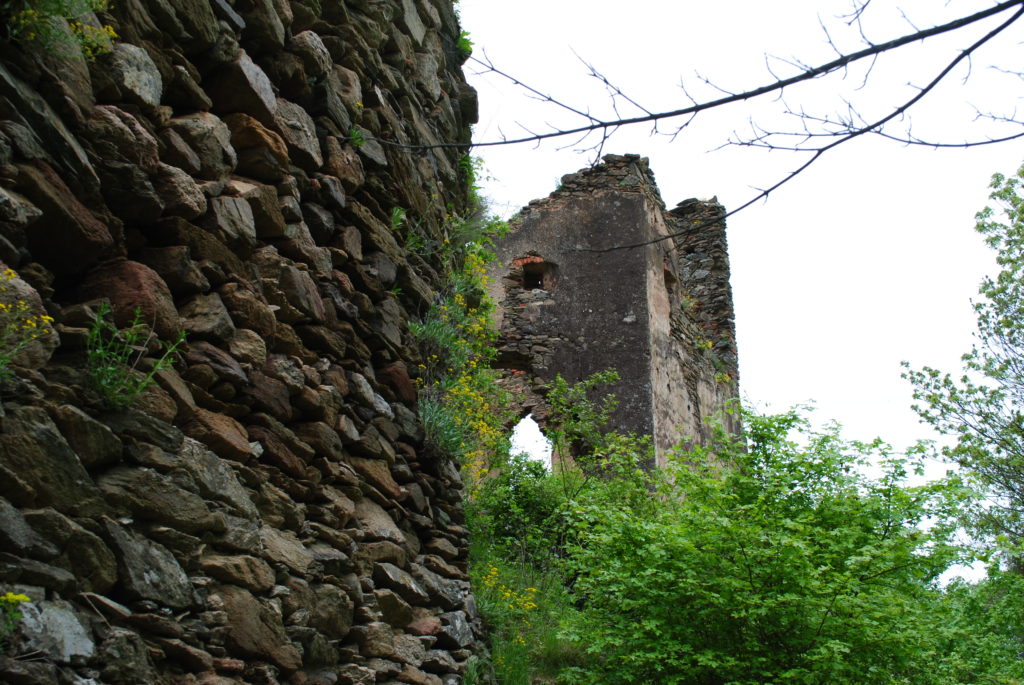
The castle of Kolcvár (Cetatea Colț) is the ancestral seat of the Hungarian Kendeffy family in Transylvania, Romania. In Hunyad County, at the foot of the Retyezát Mountains, 20 km from Hátszeg and 3 km from Malomvíz, on a high cliff, stands one of the most mysterious castles in Transylvania.

Kolcvár was built as a residential tower in the second half of the 1300s, by the Kende (later Kendeffy) family to protect themselves. Very little is known about the history of the castle, which is mentioned only a few times in written sources. In a document of 1519, it is mentioned as a castrum (castle), the property of Kendeffy Mihály and László.

During the 16th and 17th centuries, the central keep was surrounded by a strong wall in the shape of a triangle, and two polygonal towers were built on the south side to further strengthen the castle.

The origins of the Kendeffy family are disputed, with some tracing the ancestry back to Kond, one of the seven Hungarian chieftains of the home-taker Árpád. However, according to Romanian literature and the plaque next to the castle, the castle was built by the Romanian Cândea family, who converted to Catholicism in the 14th century and adopted the Hungarian name Kendeffy.

The members of the Transylvanian Kendeffy family were active in public life, many of them brave soldiers. In 1550, Kendeffy János fought against the Romanian armies threatening the Transylvanian borders, where he was sent by Martinuzzi, the White Monk who governed Transylvania.

The Kendeffy family did not live in the castle permanently, but they kept their property here. They were extremely wealthy people with large estates in the Retyezát and Hátszeg areas. From the middle of the 17th century, when the Turks raided Transylvania, they often took refuge behind the walls of the castle.

Eventually, the castle was captured by the Turks, and the husband of Kendeffy Ilona was taken away and died in captivity. A legend is also connected to this event, which can be read at the end of the article: according to the legend, Ilona could save his husband’s life. The Turkish traveler Evlija Chelebi visited its walls in 1661.

Besides the legend, Kolcvár has inspired many other literary works. One of the most famous is Jules Verne’s “Castle in the Carpathians”. This is how the author describes the location of the castle:
“The site is exceptionally beautiful, with a view from the top of the watchtower, which is flat, over the mountains. To the rear, the high mountain range undulates, giving way to a whimsical range: this is the border of Transylvania…”.

In his novel, he described it like this: “The Carpathian castle was in better condition than it appeared, but in reality, it was now protected by a contagious terror, tainted with superstition, like the great cannons, bomb-throwers, battle-snakes and other fire-engines of centuries past… The castle spread an infectious terror around it like the plague of an unhealthy swamp. To come within a quarter of a mile of it was to risk one’s life on this earth and one’s salvation in the next.”

Towards the end of the 17th century, it was again in the possession of the Kendeffys together with the manors. In 1671 it was still inhabited by a garrison. The castle has been in ruins since the 18th century. Kolcvár is set in beautiful surroundings and the castle itself must once have been beautiful, no wonder it has inspired so many writers.

Situated on a cliff, the castle was built around a square residential tower. The rectangular tower has three levels, originally even higher than the three that survived. It was protected by a ravine on the south side and surrounded by a wall on the other side. In the 16th and 17th centuries, a wing was added to the northwestern part of the wall, and the castle was fortified with smaller bastions. The remains of the latter structures are also clearly visible on the site.

Today only the remains of the castle can be seen on the top of the cliff. The castle can be seen from afar, approaching from the left from the road near the church of Kolcvár village. It is not well marked, only a few blue triangles are visible, but it is easy to find, with well-trodden paths leading uphill. It takes about half an hour to reach the castle on the path through the woods, which gradually climbs.

The view from the castle is very beautiful, with the snow-capped peaks of Retyezát in the distance on one side and the Hátszeg reservoir and the mountains behind it on the other. It was a bit sad and appalling that the information board at the castle told the unsuspecting tourist that the castle, the family, and everything is of Romanian origin. You can help by printing out the QR codes below and posting them when you visit the castle:

The Legend of Kendeffy Ilona
In the valley of Hátszeg, on a high hill, stood Kolc Castle, the most beautiful castle in the world. It was here that Kendeffy Ilona lived alone during the Crimean Tartar invasion, waiting with a sigh for her father, her brothers, and her fiancé, who were all fighting against the Tartars.
He waited and waited, but in vain, for suddenly came the news that his father had fallen in battle, and then came the other sad news that his brothers had fallen too. But there was no news of his fiancée. Poor Ilona did not know whether he had been killed or captured by the Tartars.
It was a year after a year, the Tatars had long since gone home, but there was still no news of Kendeffy Ilona’s fiancé. One evening, as he sat sighing on the balcony of the castle, the poor soul was suddenly overcome by drowsiness, fell asleep, and had a wonderful dream. He dreamt that his beloved companion stood before him and told him what was to come:
“Fair, fair lady, if you will have us together, you shall have enough gold to reach where I am in my sad captivity.”
“My God, my God,” Ilona sighed when she woke up, “what a wonderful dream this is! I wonder what it means. If she is a prisoner, she can only be in Tartary, but who has enough gold to get from here to Tartary?”
All day he pondered his dream, and in the evening he went out on the balcony again and sighed to the east. He sighed until the dream overcame him. Now he dreamed that an angel appeared and said to him:
“Do not grieve, Ilona, do not be dismayed. Take your spinning wheel and spin day and night, and you will have enough gold to reach Tartary, where your fiance is in bondage.”
So she thought, but still, she took out her spinning wheel and spun, sitting on the balcony, day and night, hardly a moment’s rest. The spindle turned silently, and behold, the thread it spun turned into a golden thread, and this thread flew silently towards the east, further, further, straight towards Tartary, and not a week passed before the thread reached the door of the dungeon in Tartary.
Suddenly the door opened, and one evening, as Ilona sat on the balcony spinning as usual, her fiancé stood before her.”

Source: https://uticelok.home.blog/2021/02/28/erdelyi-varak-es-kastelyok-kolcvar/
Dear Readers, I can only make this content available through small donations or by selling my books or T-shirts:
Please feel free to support me with a coffee here: https://www.buymeacoffee.com/duhoxoxa
You can check out my books on Amazon or Draft2Digital, they are available in hardcover, paperback, or ebook: https://www.amazon.com/dp/198020490X or at https://books2read.com/b/boYd81


My work can also be followed and supported on Patreon: Become a Patron!http://Become a Patron!

Here are more pictures of Kolc Castle:















































